Further details of the sinking of the yacht Nina Pope
We reported on the 14th March 2024 of the sinking that day of the yacht Nina Pope, two days after she had called at Tristan. We now have more information about what happened.
[This page, first published 25th March, has been amended using extra information published in the US on the 27th March.]
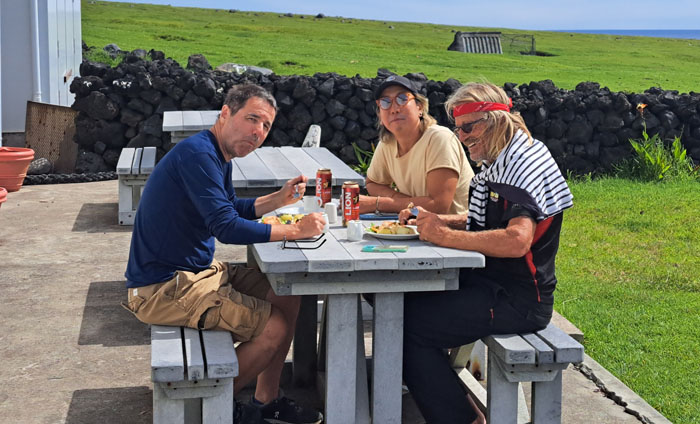
The crew of the Nina Pope on Tristan on the 12th March 2024
Left to right: Balthasar Wyss, Marcelo Osanai and skipper Benno Frey.
The Nina Pope left Rio de Janeiro on the 27th February 2024 to cross the South Atlantic to South Africa. On board were skipper Benno Frey (Swiss) and two crew, Marcelo Osanai (Brazilian) and Balthasar Wyss (Swiss American). They stopped off to visit Tristan da Cunha on the Tuesday 12th March, topped up their supplies and used the WiFi to contact their families. They had been out of touch for two weeks.
Sequence of Events
The precise timings have been difficult to ascertain, but this is what we understand happened:
When the Nina Pope departed Tristan mid-afternoon on the 12th March, they were expecting bad weather, but with good seamanship the yacht should have been able to withstand it. However, late on Wednesday 13th, the yacht hit a large floating object. According to Marcelo, this was big buoy, and a large rope tied to the buoy became tangled with the yacht's bow. This ripped down the front rail and damaged the hull. As the boat began to take on water, the bilge pump was started, but the leak proved to be too much for it.
At 00:42 on the 14th March, skipper Benno activated an emergency satellite beacon to send out a distress signal and the yacht's coordinates. Sometime later, he realised the yacht could not be saved and the survival raft was launched. Marcelo and Balthasar were sent into the raft first, but when it came to Benno's turn he was unable to unclip his safety line in time, and to the anguish of his shipmates he was pulled underwater as the yacht sank. The survival raft had been cast off though, and they also had the handheld Garmin satellite communicator, which continued to broadcast their position.
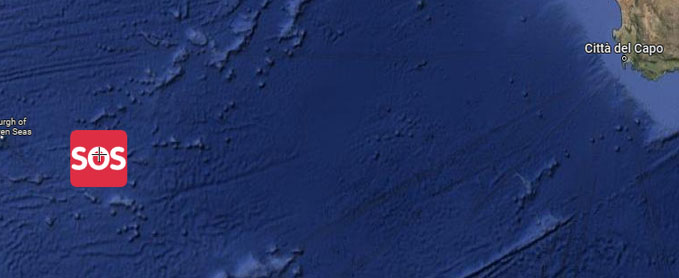
Map showing the location of the SOS relative to Tristan da Cunha and Cape Town
How the Tragedy Unfolded
The Nina Pope's distress signal was picked up by the Garmin International Rescue Coordination Center in Texas, and relayed to five different coast guard agencies. The lead was taken up my the Maritime Rescue Coordination Centre in Cape Town, who in turn relayed the Mayday to shipping near to the incident. This transmission was picked up by the oil tanker Front Pollux, travelling between Argentina and South Africa, which immediately diverted to the scene.
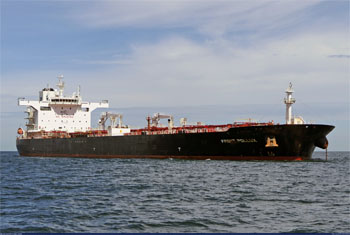 |
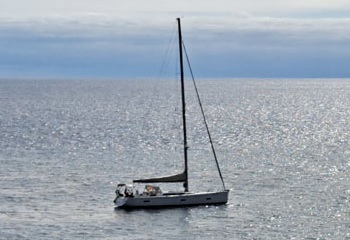 |
| The crude oil tanker Front Pollux | Nina Pope off Tristan on the 12th March 2024 |
The distress call had meanwhile also been received by the families and friends of the crew. Captain Benno's ex-wife independently emailed the Tristan website, anxious to see if the island could assist the stricken yacht. The website is hosted in the UK, but her email was quickly forwarded to the island.
The reported position of the yacht was 37.966627°S, 7.697930°W - about 230 nautical miles to the east of Tristan. This was well beyond the range of Tristan's inshore craft, and the MFV Edinburgh was also too far away. Tristan's best course of action was to alert the authorities in Cape Town, which they did. Fortunately, Cape Town was already handling matters. We updated Benno's family on the situation.
There was a lot of concern for the yacht on Tristan, and people monitored developments as far as they could online. Ship tracking sites showed the tanker changing course and approaching the yacht's position, but when the yacht's signal disappeared islanders feared the worst. Then there was some good news. Other yachtsmen with the necessary technology had also been monitoring developments, and we learned in the evening via the Boat Watch Facebook group that two crew members had been rescued. Alas, that left one person unaccounted for.
The Rescue
The survival raft would have been difficult to spot had the Garmin device not continued to transmit its position. When Front Pollux found the raft in the early afternoon, wind speeds were up to 74km/h (40 knots) and waves up to eight metres (26ft) high. The ship oriented itself to block the wind, and a line was dropped to secure the raft to the ship. They then let down ladders to the raft which enabled the survivors, with the help of the crew, to climb out of the raft onto the ship.
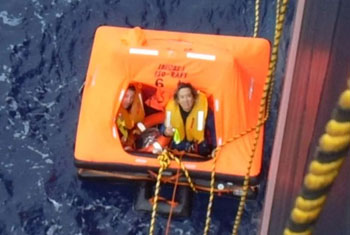 |
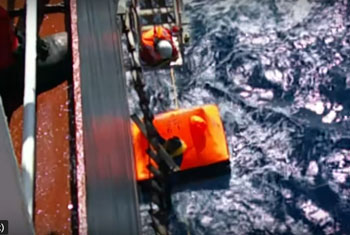 |
| The survivors in their raft and climbing the ladders onto the tanker | |
The survivors had been adrift in the raft for six hours by the time they were rescued, during which they had drifted 18 miles. However, although they were exhausted and traumatised by their experience, they were otherwise physically unharmed. They were given dry clothing and fed by the tanker's crew, and were given the opportunity to contact their families and friends at home.
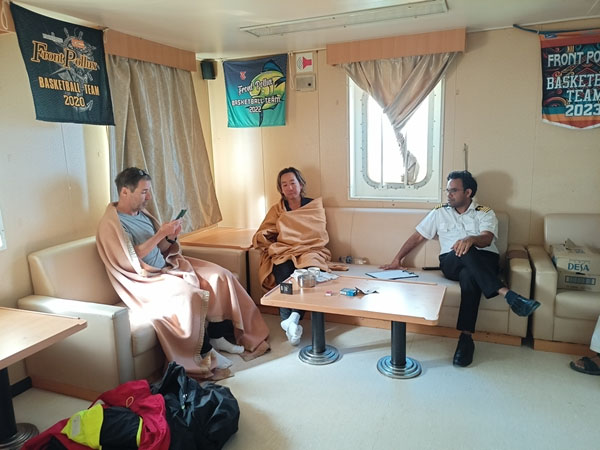
The survivors Balthasar (left) and Marcelo (centre) on the Front Pollux recovering from their ordeal with Captain Ravi Yadav, and contacting the families and friends.
We are very grateful that that evening the wife of one of the survivors, and the next morning one of the survivors himself took the trouble to send brief messages with the news to Tristan via the website. It was very considerate of them to think of Tristan at such a difficult time.
Aftermath and Further Information
The rescue of the two crewmen and the fatality were officially announced on the 15th March by the South African Maritime Safety Authority (SAMSA). The Front Pollux proceeded to Cape Town, where the survivors were disembarked on Monday 18th March and placed into the care of their respective national consulates.
SAMSA issued an update to their report on the 19th March, which included the dramatic pictures of the rescue shown here, captured by the crew of the Front Pollux. Further details also emerged on the Brazilian news website Universo Online (in Portuguese), and journalist Jamie Pyatt wrote a report with more background from the families for the UK's Daily Mail. Balthasar's account of the incident was published in the Mercer Island Reporter on the 27th March following his return home to Seattle.
The Problem of Drifting Objects
Large objects adrift in the oceans are an increasing hazard to shipping, as Tristan knows from some of the things that have washed up on her shores. For instance, a 10m long steel mooring buoy, maybe of the same type involved in this incident, turned up near Boatharbour in 2010. But this is by no means the biggest object to have washed up at Tristan. A complete oil platform ran aground at Trypot in 2007. The rig had had to be cast adrift in bad weather while being towed across the South Atlantic and eye contact was lost until islanders spotted it aground while out fishing.
Tristan and Maritime Emergencies
Tristan da Cunha has a long history of helping distressed mariners as far as it is able to do so. On hearing of the death of the skipper, islander Iris Green summed up every Tristanian's thoughts on the latest emergency with the following words:
"We are thinking of his family and the family of the two crew that were rescued.
Tristan may be remote but the sailors that touched our shores are always remembered."
